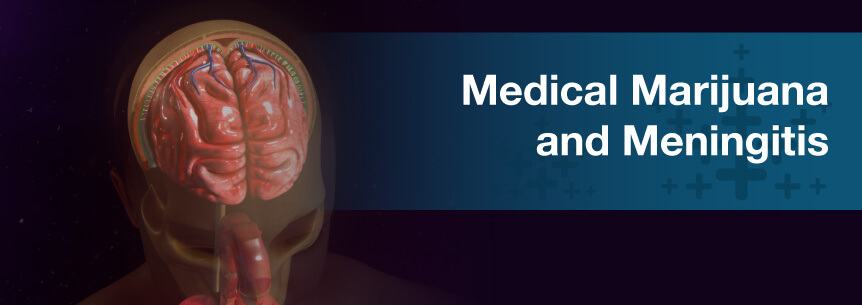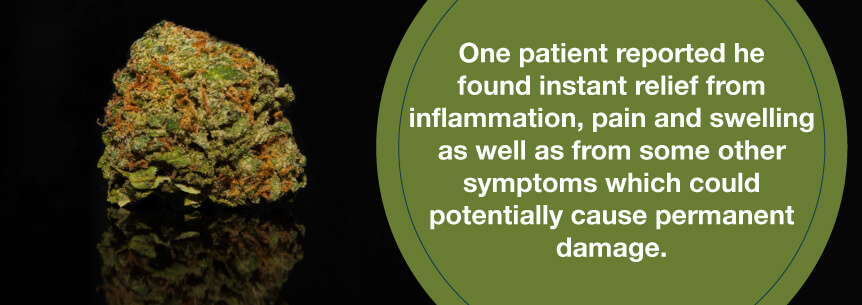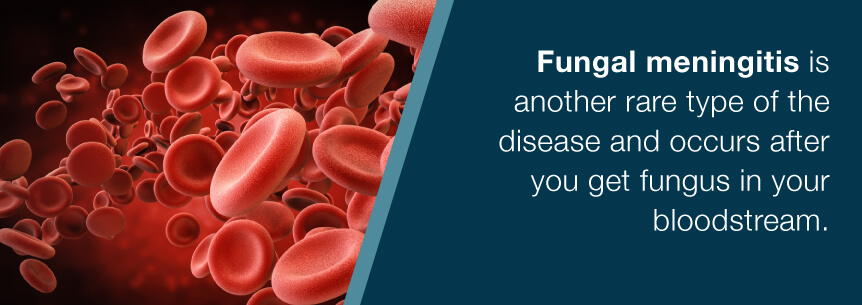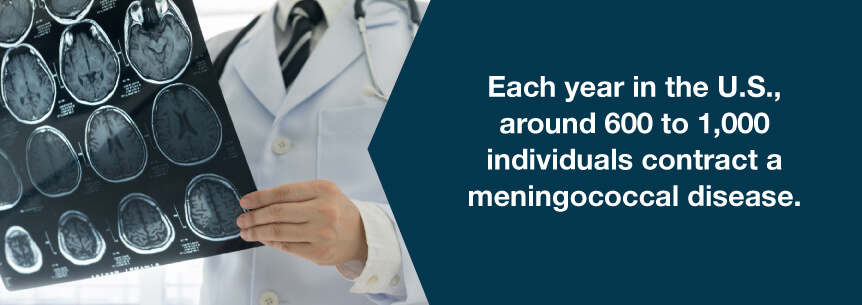
Meningitis is a central nervous system disorder that affects the functioning and health of your brain and spinal cord. Studies show marijuana may restrict the progression of a whole range of central nervous system disorders like meningitis, managing its range of symptoms such as chronic pain, muscle spasms and seizures. Continue reading to learn more about medical marijuana for meningitis.
Endocannabinoids (ECs) work through the process of neuroprotection, immunomodulation and inflammation control of your central nervous system. Cannabinoid type 2 receptor (CB2) activation helps reduce pro-inflammatory factor release and increase anti-inflammatory cytokine secretion.
Endocannabinoid 2-arachidonoyl glycerol (2-AG) induces eosinophil migration: the movement of white blood cells into the blood. CB2-receptor-dependent mechanisms can occur in peripheral blood — the cellular components of blood: white blood cells, red blood cells and platelets — while activating neutrophils, the most abundant white blood cells in most mammals.
One study centered on dogs with an upregulated endocannabinoid system and inflammatory central nervous system diseases, calling attention to the endocannabinoid system being a potential inflammatory CNS-disease treatment.
Other study showed how medical marijuana has neuroprotective effects, thereby supporting brain and spinal cord health while also helping to treat a range of CNS disorders. Cannabis’s cannabinoids, including THC, protect astrocytes and neurons effectively from damage, assist in neuroregeneration and modulate inflammatory reaction.
Find A Doctor Find A Dispensary
There’s little research on medical cannabis for meningitis. However, many patients share their anecdotal stories to help educate and provide relief to other meningitis patients, assisting in increased public knowledge for a better understanding of medical weed and its possibilities.

One patient, in particular, reported he found instant relief from inflammation, pain and swelling as well as from some other symptoms which could potentially cause permanent damage. He claimed marijuana for meningitis could give the antibiotics time to work and buy the patient time. He believes medical pot allowed his body to heal without any long-term disabilities or life-threatening complications.
Overall, medical marijuana for meningitis can help with symptoms such as:
The power of medical cannabis and meningitis treatment shows a lot of potential for relieving a range of meningitis symptoms.
Until Congress allows research organizations and universities to study marijuana concentrates, flowers and edibles thoroughly, patients, caretakers and doctors will stay in the dark as far as what strains of weed are most effective for different forms of brain inflammation like meningitis.
However, patients’ anecdotal reports and studies have already shown certain strains help treat certain symptoms like nausea, sleepiness, pain and depression.
Although all medical cannabis provides patients with similar benefits, indica and sativa strains differ from one another.
Benefits of indica strains include:
Benefits of sativa include:
Hybrids of marijuana provide a cross-section of benefits. Many increase relaxation and reduce nausea. Below are only some of the many symptoms marijuana and meningitis therapy treats:
Because meningitis is an often distressing and stressful condition, many report strains that have a positive impact on your mood to be additionally beneficial. Some good “mood” strains include:
All three of these strains are euphoric as well.
The number of cannabis forms for meningitis treatment can overwhelm patients who are just getting started with this method of medication. However, having a variety of delivery methods is what sets cannabis apart from more traditional pharmaceuticals. Methods include:
Each delivery method will have a different desired effect as individuals use them for various conditions.
If you’re looking for more information on medical cannabis — be that strains, methods of use, research or general information — or if you’re interested in a professional consultation with a medical marijuana physician, conduct a search today.
Marijuana Doctor’s proudly pre-screens all our cannabis doctors to ensure they’re licensed and experienced enough to prescribe you medical cannabis. We can assist you in finding the right marijuana strain, product and method of administration. You can also search amongst our accredited list of cannabis dispensaries.
Find A Doctor Find A Dispensary
Meningitis is the swelling or inflammation of your brain’s and spinal cord’s protective membranes. A viral or bacterial infection of the fluid surrounding your spinal cord and brain typically causes this kind of swelling. However, other things can cause meningitis as well, such as:
Since treatment depends on the individual cause of meningitis, it’s essential to identify which of these health concerns is the source.
According to the Centers for Disease Control and Prevention (CDC), around one in 10 individuals carries a meningitis germ in their throat or nose but displays no symptoms or signs of the disease. Medical experts refer to these people as carriers.
Certain activities a carrier performs may infect other people. These activities include:
People who are susceptible may develop an infection after exposure to the meningitis-causing bacteria. While this condition is particularly common in some age groups, anybody can get meningitis. The most at-risk age groups are:

Individuals with certain health conditions are at a higher risk as well for meningitis. A few of these conditions are long-term diseases, missing or damaged spleens or immune-system disorders.
Since certain meningitis germs can easily spread, there’s more risk of outbreaks occurring in places where everyone lives close to one another. Military recruits in barracks or college students in dorms have a higher risk of contracting the disease. So are individuals traveling to certain geographical regions — like parts of Africa where the disease is more common.
The different types of meningitis are:
Bacterial meningitis can be a life-threatening condition. It can cause severe problems like hearing loss, brain damage and even death if doctors don’t diagnose and treat it immediately. This type of meningitis occurs after bacteria reaches your bloodstream and travels to your spinal cord and brain.
There are numerous bacteria strains that may potentially lead to this type of meningitis, such as:
People can transfer these bacteria through sneezing, coughing or saliva transfer during mouth-to-mouth resuscitation or kissing. Eating contaminated food can cause certain bacterial meningitis types as well, although the source is sometimes unknown.
Another type is viral meningitis, which is more common than the bacterial type but typically not as severe. Enteroviruses cause many viral meningitis cases. However, chicken pox, measles, mumps and other common viruses can cause it too, including some viruses picked up by mosquitos and other insects and transferred to humans.
Fecal contamination can spread viral meningitis, usually when people don’t wash their hands properly after using the toilet or changing diapers. Enteroviruses may also spread through nose, mouth or eye secretions or blister fluid.
A Naegleria fowleri parasite is the cause of a rare form of parasitic meningitis known as primary amebic meningoencephalitis (PAM). This type causes a rapidly progressing brain infection that’s often fatal.
People detect naegleria fowleri all across the globe in warm freshwater sources like rivers, hot springs and lakes. This parasite also resides in:
This type of microscopic organism travels through the nose and into the brain, where it starts destroying brain tissue. You can’t transfer parasitic meningitis through person-to-person contact.
Fungal meningitis is another rare type of the disease and occurs after you get fungus in your bloodstream. Although anybody can contract this type of meningitis, those with a weakened immune system are more susceptible. You can get fungal meningitis by inhaling fungal spores from a bat or bird droppings as well as contaminated soil.

Similar to fungal and parasitic meningitis, this type of meningitis cannot spread through person-to-person contact. Instead, you usually get this type as a result of things like:
References to meningitis stem back to ancient texts, with one of the earliest descriptions found in the work Hippocrates. Sir Robert Whytt, an Edinburgh physician, was the first to describe tuberculous meningitis in a 1768 posthumous report. However, it took another hundred years to identify the association with tubercle bacilli causing tuberculosis.
The first recording of a meningitis outbreak was in 1805 in Geneva, Switzerland. Andre Matthey (1778-1842) and Gaspard Vieusseux (1746-1814) made a description of the epidemic (meningococcal) meningitis — while around this time in the United States, Massachusetts resident Elisa North (1771-1843) did as well. Shortly after this, researchers described a few other epidemics in the U.S. and Europe. Today, up to 1,000 people get meningitis infections each year in the U.S., according to the National Meningitis Association.
Bacterial and viral meningitis symptoms can be similar at first. But, the symptoms of bacterial meningitis are often more severe. Symptoms you experience will also depend on how old you are.
Infants may experience:
Adults may experience:
Symptoms of this type of meningitis can develop suddenly and can include:
If you start experiencing these symptoms, seek medical attention immediately. Bacterial meningitis can lead to death. You can’t determine if you have viral or bacterial meningitis by simply judging how you feel. A physician will determine the type by running tests.
Individuals who contract meningitis can experience both physical and mental effects.
There can be many physical complications with meningitis, such as:
Some individuals experience daily emotional changes after meningitis. Each person responds to their condition differently and these changing emotional states will vary depending on the person’s age.
Teens may find it hard to communicate their emotions and could also experience a period of depression. Younger children often experience bedwetting, nightmares, temper tantrums and clinginess. Both adults and children can experience depression and anxiety, lack of confidence and self-esteem and behavioral problems like mood swings and aggression. Understanding and patience is usually the best action to take, as some individuals may require more support to get through the mental hardships meningitis can cause.
According to the National Meningitis Association, common meningitis statistics include:

The current best treatment for meningitis is prevention.
Preventative measures start with maintaining a healthy lifestyle, particularly if you’re in a high-risk category. A healthy lifestyle means:
If you do come in contact with someone who has a bacterial meningococcal infection, a physician may prescribe preventive antibiotics to reduce the likelihood of developing the condition.
A doctor may also recommend vaccinations, which help protect against certain meningitis forms. These vaccines include:
The cause of a meningitis strain will determine its treatment.
Many types will require immediate hospitalization if developed from bacterial meningitis. Early diagnosis and treatment should prevent undue suffering and brain damage or death. A doctor will prescribe intravenous antibiotics to treat bacterial meningitis. The type of antibiotic depends on the bacteria involved. Side effects of antibiotics may include:
A doctor will prescribe antifungal agents for fungal meningitis. Side effects of antifungal agents may include:
There’s no treatment for viral meningitis, as it tends to resolve on its own. Patients should find symptom relief within a couple of weeks with no serious long-term complications.